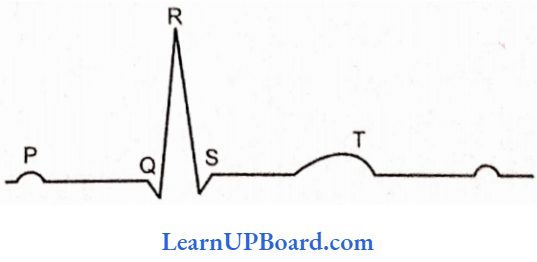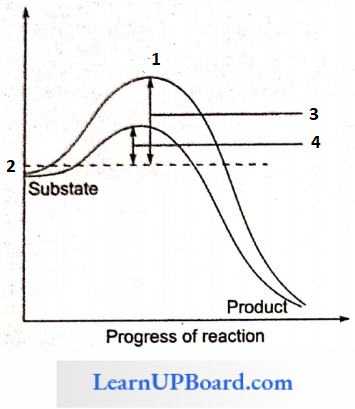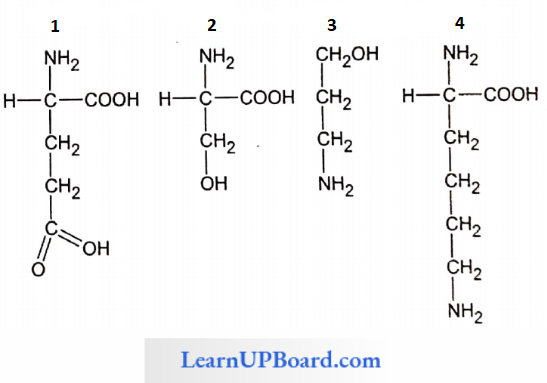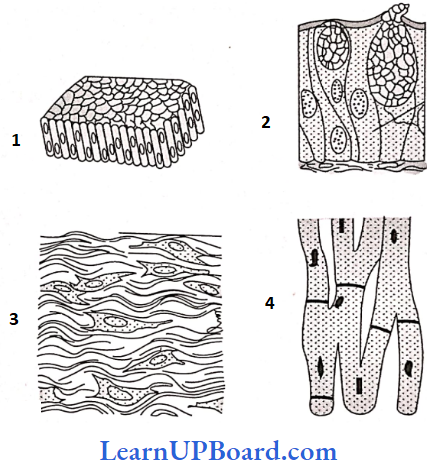NEET Biology For Animal Kingdom Multiple Choice Questions
Question 1. Pick the odd pair out.
- Cellular Level: Porifera
- Tissue Level: Aschelminthes
- Organ Level: Phatyhelminthes
- Organ System Level: Annelida
Answer: 2. Tissue Level: Aschelminthes
Question 2. Animals possess various types of symmetry. Select the correctly matched.
- Echinodermates possess radial symmetry.
- Arthropods possess bilateral symmetry.
- Sponges are mostly asymmetrical.
- All of these.
Answer: 4. All of these
Question 3. Select the group of organisms given below that have diploblastic members only.
- Ctenoplana, Taenia, Fasciola
- Euspongia, Physalia, Meandrina
- Wuchereria, Culex, Limulus
- Aedes, Ascaris, Hydra
Answer: 2. Euspongia, Physalia, Meandrina
Question 4. In Deuterostomia, blastopore forms
- Mouth
- Anus
- Both
- None
Answer: 2. Anus
Question 5. Open blood vascular system is found in
- Saccoglossns
- Anopheles
- Pila
- All of these
Answer: 4. All of these
Biology MCQs with answers
Question 6. Select the pseudocoelomates from the list of organisms given below.
- Ascaris, Fasciola, Taenia
- Culex, Locusta, Limulus
- Wuchereria, Ascaris, Ancylostoma
- Nereis, Hirudinaria, Wuchereria
Answer: 3. Wuchereria, Ascaris, Ancylostoma
Question 7. Closed blood vascular system found in
- Bombyx
- Sepia
- Balanoglossus
- Ascidia
Answer: 2. Bombyx
Question 8. The animals in which cells are organized into structural and functional units called as tissues, organs, and organ systems are grouped under which subkingdom?
- Parazoa
- Eumetazoa
- Metazoa
- Bilateria
Answer: 2. Eumetazoa
Question 9. When any plane passing through the central axis of the body divides the organism into two identical halves, it is radial symmetry. Which of the following set of animals has radial symmetry?
- Housefly, fish, human beings
- Sponges, hydra, crabs
- Coelenterates, ctenophores, echinoderms
- Annelids, arthropods, housefly
Answer: 3. Coelenterates, ctenophores, echinoderms
Question 10. A closed circulatory system is found in
- Earthworm
- Arthropoda
- Unio
- Leech
Answer: 1. Earthworm
” phylum aschelminthes”
Question 11. Sponges are the most primitive multicellular organisms with which of the following levels of organization?
- Acellular
- Cellular
- Tissue
- Organ system
Answer: 2. Cellular
Biology MCQs with answers
Question 12. An incomplete alimentary canal with a blind sac type of body plan is present in
- Annelids
- Arthropods
- Platyhelminthes
- Sponges
Answer: 3. Platyhelminthes
Question 13. Select incorrect matching of animals, their body symmetry, and coelom.

Answer: 4
Question 14. Acoelomate diploblastic animal phylum is
- Platihelminthes
- Cnidaria
- Aschelminthes
- Hemichordata
Answer: 2. Cnidaria
Question 15. Which of the following animal(s) has the tube-within-tube type of body plan evolved along the deuterostomic evolutionary line?
- Annelids
- Arthropods
- Echinoderms
- Molluscs
Answer: 1. Annelids
Question 16. In the course of evolution, true coelom appeared for the first time in
- Annelida
- Chordata
- Aschelminthes
- Echinodermata
Answer: 1. Annelida
Question 17. Which of the following is the incorrect matching of the phylum, their alimentary canal, and metameric segmentation?
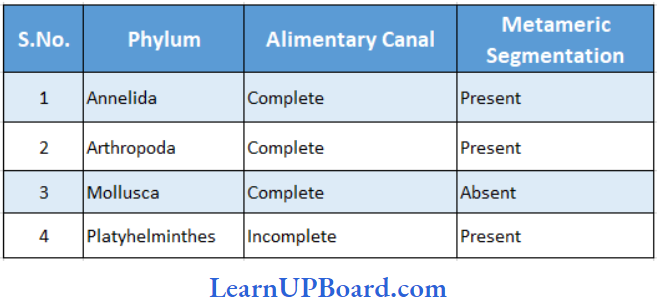
Answer: 4
Question 18. Sponges in which the cells are loosely aggregated and do not form tissues or organs are grouped under which subkingdom?
- Metazoa
- Eumetazoa
- Parazoa
- Bilateria
Answer: 3. Parazoa
Biology MCQs with answers
Question 19. The level of organization in coelenterates is
- Acellular
- Cellular
- Tissue
- Organ system
Answer: 3. Tissue
Question 20. The blind sac body plan is found in
- Sponges
- Annelids
- Coelenterates
- Roundworms
Answer: 3. Coelenterates
Question 21. Annelids possess
- Cell aggregate plan
- Blind sac plan
- Tube within a tube plan
- Hollow sac plan
Answer: 3. Tube within a tube plan
Question 22. “Tube in a tube” plan is not exhibited by which one of the following phyla?
- Coclenterata
- Aschelminthes
- Annelida
- Arthropoda
Answer: 1. Coclenterata
Question 23. An animal having a triploblastic coelomic condition is
- Ascaris
- Periplaneta
- Planaria
- Sycon
Answer: 3. Planaria
Question 24. Animals that are triploblastic with tube-within-tube type of body plan and embryonic blastopore forms anus (deuterostomes) are
- Annelids
- Molluscs
- Platyhelminthes
- Echinoderms
Answer: 4. Echinoderms
Question 25. Echinoderms and chordates have
- Pseudocoel
- Shizocoelom
- Enterocoelom
- Hemocoel
Answer: 3. Enterocoelom
Question 26. The body cavity of arthropods is called
- Coelom
- Hemocoel
- Pseudocoel
- Gastrovascular cavity
Answer: 2. Hemocoel
NEET Biology MCQ With Solutions
Question 27. A deuterostome animal is
- Starfish
- Sea anemone
- Pearl oyster
- Octopus
Answer: 1. Starfish
Question 28. True segmentation (metameric) occurred for the first time in
- Platyhelminthes
- Aschelminthes
- Annelids
- Arthropods
Answer: 3. Annelids
Question 29. Animals possessing pseudocolor are
- Flatworms
- Roundworms
- Annelids
- Molluscs
Answer: 2. Roundworms
Question 30. True coelom appeared first in the course of evolution in
- Echinodermata
- Annelida
- Chordata
- Aschelminthes
Answer: 2. Annelida
Question 31. Biradial symmetry is found in
- Obelia
- Sea anemone
- Hydra
- Aurelia
Answer: 2. Sea anemone
Question 32. Which is the only phylum in the animal kingdom without any nerve cell?
- Porifera
- Coelenterata
- Annelida
- Eumetazoa
Answer: 1. Porifera
Question 33. The basis of the classification of protozoa is
- Mode of nutrition
- Mode of reproduction
- Mode of locomotion
- Mode of respiration
Answer: 3. Mode of locomotion
Question 34. Dum-dum fever is caused by
- Leishmania donovani
- Gloss in a pal is
- Giardia intestinal is
- Trypanosoma ambient
Answer: 1. Leishmania donovani
NEET Biology MCQ With Solutions
Question 35. The relationship between Lophomonas and wood cock¬roach is of
- Parasitism
- Commensalism
- Symbiosis
- Ammensalism
Answer: 3. Symbiosis
“triploblastic animals “
Question 36. Oriental sore disease in man is caused by which one of the following?
- Leishmania tropica
- L. donovani
- L. brasiliensis
- Phlebotomus intermedins
Answer: 1. Leishmania tropica
Question 37. Trypanosoma gambiense causes
- Sleeping sickness
- Yellow fever
- Kala-azar
- Oriental sore
Answer: 1. Sleeping sickness
Question 38. The vector of Trypanosoma gambiense is
- Sandfly
- Fruit fly
- Tsetse fly
- House fly
Answer: 3. Tsetse fly
Question 39. Sarcodine-causing dysentery is
- Giardia
- Entamoeba
- Amoeba
- Trypanosoma
Answer: 2. Entamoeba
Question 40. Silica shells may or may not occur in which one of the following?
- Amoeboids
- Heliozoans
- Radiolarians
- Foraminiferans
Answer: 2. Heliozoans
Question 41. The time period from the initial infection to the first appearance of symptoms is known as
- Pre-patent period
- Incubation period
- Pre-erythrocytic period
- Exo-erythrocytic period
- Answer: 2. Incubation period
Question 42. The tetra nucleated cyst stage is found in
- Entamoeba coli
- Entamoeba histolytica
- Leishmania
- Trypanosoma
Answer: 2. Entamoeba histolytica
Question 43. Which of the following organisms is known to form abscesses in the human liver, lungs, brain, etc.?
- Entamoeba histolytica
- Monocyst is
- Plasmodium
- Fasciola hepatica
Answer: 1. Entamoeba histolytica
Question 44. Which one of the following constitutes the reserve food material in the cyst of Entamoeba histolytica?
- Volutin granules
- Starch granules
- Glycogen granules
- Fat droplets
Answer: 3. Glycogen granules
Question 45. Slipper Animalcule is the name of
- Pelomyxa
- Actinophrys
- Euglena
- Paramecium
Answer: 4. Paramecium
Question 46. Organelle concerned with offense and defense in Paramecium is
- Trichocyst
- Radial canals
- Kappa particles
- Peristome
Answer: 1. Trichocyst
Question 47. Conjugation in Paramecium is by
- Exchange of micronucleus
- Exchange of macronucleus
- Exchange of + and – nuclei
- Exchange of nuclei
Answer: 1. Exchange of micronucleus
NEET Biology MCQ With Solutions
Question 48. The function of cytology in Paramecium is to
- Filter food particles
- Form the bolus of the food material
- Segregate debris from useful food material
- Egest the indigestible waste
Answer: 4. Egest the indigestible waste
Question 49. Contractile vacuoles of Paramecium are analogous to
- Sweat glands of mammals
- Uriniferous tubules
- The gastrovascular cavity of Hydra
- Typhlosole of Earthworm
Answer: 2. Uriniferous tubules
Question 50. The removal of micronucleus in Paramecium will impair the function of
- Reproduction
- Excretion
- Osmoregulation
- Locomotion
Answer: 1. Reproduction
Question 51. Locomotion in sporozoans occurs by
- Flagella
- Cilia
- Pseudopodia
- Wriggling movement
Answer: 4. Wriggling movement
Question 52. The most important characteristic of phylum Porifera is that the organisms
- Are acellular
- Possess blind sac type of body plan
- Possess canal system and choanocytes
- Possess water vascular system
Answer: 3. Possess canal system and choanocytes
Question 53. Most of the sponges are marine and remain attached to rocks (sessile). The freshwater sponge is
- Sycon
- Spongilla
- Cliona
- Euplectella
Answer: 2. Spongilla
Question 54. The path of water in a sponge is
- Dermal ostia → Gastral ostia → Osculum
- Dermal ostia → Gastral ostia → Spongocoel → Osculum
- Osculum→ Spongocoel → Choanocytes→ Ostia
- Pinacocytes → Choanocytes → Enteron → Osculum
Answer: 2. Dermal ostia → Gastral ostia → Spongocoel→Osculum
Question 55. The movement of water in the second type of canal system is

Answer: 2
Question 56. Which one of the following cells is totipotent and responsible for regenerative capacity in sponges?
- Pinacocytes
- Thesocytes
- Archaeocytes
- Scleroblast
Answer: 3. Archaeocytes
Question 57. The skeleton of the bath sponge, Euspongia, is made of
- Spongin fibers
- Siliceous spicules
- Calcareous spicules
- Spongin fibers and siliceous spicules
Answer: 1. Spongin fibers
Question 58. A sponge harmful to the oyster industry is
- Spongilla
- Euspongia
- Hyalonema
- Cliona
Answer: 4. Cliona
Question 59. Which of the following lives in a commensal relationship with shrimps and is called as Venus flower basket?
- Leucosolenia
- Euplectella
- Euspongia
- Sycon
Answer: 2. Euplectella
Question 60. The larva of Leucosolenia is
- Parenchymula
- Amphiblastula
- Planula
- Trochophore
Answer: 1. Parenchymula
NEET Biology MCQ With Solutions
Question 61. The mode of digestion in sponges is
- Intracellular
- Intercellular
- Intracellular and intercellular
- None of these
Answer: 1. Intracellular
Question 62. The spongocoel of sponges is homologous to the
- True coelom of earthworm
- Hemocoel of cockroach
- Pseudocoelom of Ascaris
- None of these
Answer: 4. None of these
Question 63. In the absence of a closed vascular system, how do sponges manage to distribute the nutritive substances from choanocytes to rest of the cells?
- Through cell-to-cell diffussion
- Through mesoglea which acts as the food reservoir and distribution system
- Through the wandering cells, amoebocytes
- Through cell-to-cell diffusion and amoebocytes
Answer: 4. Through cell-to-cell diffusion and amoebocytes
Question 64. Hydra and Obelia are/have
- Diploblastic, blind sac body plan, radial symmetry, acoelomate
- Diploblastic, bilaterally symmetrical, acoelomate
- Triploblastic, radially symmetrical, coelomate
- Triploblastic, bilaterally symmetrical, coelomate
Answer: 1. Diploblastic, blind sac body plan, radial symmetry, acoelomate
Question 65. The most important characteristic of phylum Cnidaria is
- Cnidoblasts
- Choanocytes
- Thesocytes
- Archaeocytes
Answer: 1. Cnidoblasts
Question 66. The digestion in Hydra is
- Extracellular
- Intracellular
- Extracellular and intracellular
- Holozoic
Answer: 3. Extracellular and intracellular
Question 67. Metagenesis is found in
- Physalia (Portuguese man of war)
- Hydra
- Obelia
- Both (1) and (3)
Answer: 4. Both (1) and (3)
Question 68. Which of the following statements is incorrect about metagenesis?
- The alternation of asexual and sexual phases in the life cycle of Obelia is called metagenesis.
- Metagenesis is similar to alternation of generations as found in plants.
- Both the medusa and polyp arc are diploid.
- Medusa is the sexual phase and polyp is the asexual phase.
Answer: 2. Metagenesis is similar to the alternation of generations as found in plants.
Question 69. Jellyfish belong to a class
- Hydrozoa
- Scyphozoa
- Anthozoa
- None of these
Answer: 2. Scyphozoa
Question 70. Sea anemone belongs to
- Anthozoa
- Hydrozoa
- Scyphozoa
- Coelenterata
Answer: 1. Anthozoa
Question 71. Which one of the following
- Sea pen
- Sea horse
- Sea urchin
- Sea cucumber
Answer: 1. Sea pen
NEET Biology MCQ With Solutions
Question 72. Mark the incorrect match?
- Obelia—Planula larva
- Aurelia—Ephyra larva
- Nereis—Trochophore
- Hydra—Hydrula larva
Answer: 4. Hydra—Hydrula larva
Question 73. Hypnotoxin is produced by
- Penetrant
- Volvent
- Large glutinant
- Small glutinant
Answer: 1. Penetrant
Question 74. During the discharge of nematocyst, the function of the lasso is to
- Press and squeeze out the threaded tube
- Trigger the stimulus
- Prevent the detachment of nematocyst from nematoblast
- None of these
Answer: 3. Prevent the detachment of nematocyst from nematoblast
Question 75. A piece of Hydra will regenerate into a full Hydra if it contains a part of
- Epidermis
- Epidermis, gastrodermis, and interstitial cells
- Basal disc
- Epidermis, gastrodermis, and tentacles
Answer: 2. Epidermis, gastrodermis, and interstitial cells
Question 76. Which one of the following (cell types) contains the symbiotic Zoochlorellae in Hydra?
- Epithelio muscular cells of epidermis
- Endothelial muscular cells of the gastrodermis
- Interstitial cells
- Algae embedded in the mesoglea
Answer: 2. Endothelio muscular cells of gastrodermis
Question 77. If the body stalk of Hydra is cut transversely into several segments, then in these fragments, tentacles would regenerate
- At the end that was close to the hypostome
- At the end that was close to the basal disc
- Randomly at either ends of the cut segments
- In none of the segments
Answer: 1. At the end that was close to the hypostome
Question 78. The main function of interstitial cells is
- Replacement of lost cells
- Excretion
- Digestion
- Defense
Answer: 1. Replacement of lost cells
Question 79. The organ pipe coral is
- Tubipora
- Gorgonia
- Pennatula
- Mecmdrina
Answer: 1. Tubipora
Question 80. Which animal has been placed in the wrong habitat?
- Hydra vulgaris—sea water
- Hydra gangetica—freshwater
- Obelia—seawater
- Physalia—seawater
Answer: 1. Hydra vulgaris—seawater
NEET Biology practice mcq questions with solution
Question 81. Which of the following belongs to the phylum Ctenophora?
- Hormiphora
- Cestwn
- Beroe
- All of these
Answer: 4. All of these
Question 82. Which of the following are triploblastic, acoelomate with blind sac type of body plan, and parenchyma cells originating from mesoderm fill up the cavities of the body?
- Cnidarians
- Platyhelminthes
- Annelids
- Arthropoda
Answer: 2. Platyhelminthes
Question 83. In platyhelminthes, the excretory organs are
- Nephridia
- Nephrons
- Flame cells
- Archetypes
Answer: 3. Flame cells
Question 84. Tapeworm is placed in the class
- Cestoda
- Trematoda
- Sporozoa
- Turbellaria
Answer: 1. Cestoda
Question 85. Which one of the following stages in the life history of liver fluke infects the sheep?
- Miracidium
- Media
- Cercaria
- Metacercaria
Answer: 4. Metacercaria
Question 86. The correct sequence of various larvae in liver fluke is
- Miracidium, sporocyst, cercaria, redia, metacercaria
- Miracidium, sporocyst, redia, cercaria, metacercaria
- Sporocyst, redia, miracidium, cercaria, metacercaria
- Cercaria, sporocyst, redia, miracidium, metacercaria
Answer: 2. Miracidium, sporocyst, redia, cercaria, metacercaria
Question 87. A branched uterus containing fertilized capsules can be seen in tapeworms in
- Immature proglottid
- Mature proglottid
- Gravid proglottid
- Immediately below neck
Answer: 3. Gravid proglottid
Question 88. The mature proglottids having fertilized eggs in the uter¬us of tapeworm are regularly detached. This process is known as
- Apolysis
- Proliferation
- Strobilation
- Topolysis
Answer: 1. Apolysis
Question 89. Taenia saginata differs from Taenia solium in
- Absence of scolex hooks
- Scolex devoid of hooks and differences in secondary host
- The absence of scolex hooks and the presence of both male and female reproductive organs
- Presence of scolex hooks
Answer: 2. Scolex devoid of hooks and difference in a secondary host
Question 90. Fluke occurring in human beings is
- Fasciolopsis
- Fasciola
- Dugesis
- Male Ascaris
Answer: 1. Fasciolopsis
Question 91. Schistosoma is known as
- Blood fluke
- Chinese liver fluke
- Dog tapeworm
- Lung fluke
Answer: 1. Blood fluke
Question 92. A ladder-like nervous system with ventral nerve chords is present in
- Cnidaria
- Platyhelminthes
- Annelida
- Arthropoda
Answer: 2. Platyhelminthes
Question 93. The larva of Taenia solium is called
- Cysticercus
- Megascolex
- Planula
- Ephyra
Answer: 1. Cysticercus
Question 94. The alimentary canal is absent in
- Planaria
- Tapeworm
- Blood fluke
- Liver fluke
Answer: 2. Tapeworm
Question 95. Male Ascaris differs from the female in having
- Lips
- Amphids
- Pineal spicules
- Tail
Answer: 3. Pineal spicules
Question 96. The epidermis of Ascaris is
- Multicellular
- Syncytial
- Columnar
- Cuboidal
Answer: 2. Syncytial
Question 97. A free-living roundworm is
- Enterobius
- Rhabditis
- Dracunculus
- Trichinella
Answer: 2. Rhabditis
NEET Biology practice mcq questions with solution
Question 98. The most common worm in children is
- Ascaris lumbricoides
- Enterobius vermicularis
- Ancylostoma duodenals
- Trichinella sprialis
Answer: 2. Enterobius vermicularis
Question 99. Which is the infective stage of Ascaris for man?
- First larval stage
- Second larval stage (rhaditifonn larva)
- Encysted egg
- Adult
Answer: 2. Second larval stage (rhaditifonn larva)
Question 100. What name is given to the condition of testis in Ascaris?
- Monodelphic
- Didelphic
- Monarchic
- Alarchic
Answer: 3. Monarchic
Question 101. Leech belongs to the class
- Polychaeta
- Oligochaeta
- Hirudinea
- Archiannelida
Answer: 3. Hirudinea
Question 102. Aphrodite (sea mouse) belongs to class
- Hirudinea
- Oligochaeta
- Archiannelida
- Polychaeta
Answer: 4. Polychaeta
Question 103. Parapodia for locomotion are found in one of the following.
- Earthworm
- Hirudinaria
- Nereis
- Polygordius
Answer: 3. Nereis
Question 104. A temporary clitellum occurs during the breeding season in
- Pheretima
- Heteronereis
- Hirudinaria
- Aphrodite
Answer: 3. Hirudinaria
Question 105. The septal and pharyngeal nephridia open into the alimentary canal and are of enteronephric type. These are an adaptation for
- Conservation of water (osmoregulation)
- Conservation of heat
- Regulation of temperature
- Regulation of amino acids
Answer: 1. Conservation of water (osmoregulation)
Question 106. The blood of Pheretima is
- Blue with hemocyanin in corpuscles
- Blue with hemocyanin in plasma
- Red with hemocyanin in corpuscles
- Red with hemoglobin in plasma
Answer: 4. Red with hemoglobin in plasma
Question 107. Hirudinaria shows locomotion by
- Looping
- Swimming
- Both (1) and (2)
- Creeping
Answer: 3. Both (1) and (2)
Question 108. In earthworms, fertilization occurs in
- Oviduct
- Spermathecae
- Clitellum
- Cocoon
Answer: 4. Cocoon
Question 109. One of the following is considered as a connecting link between Annelida and arthropods.
- Peripatus
- Limulus
- Balanoglossus
- Sphenodon
Answer: 1. Peripatus
NEET Biology practice mcq questions with solution
Question 110. Peripatus breathes by
- Skin
- Gills
- Trachea
- Book lung
Answer: 3. Trachea
“incomplete digestive system “
Question 111. Respiration in mollusca takes place by
- Body surface
- Gills or ctenidia
- Pulmonary sac
- All of these
Answer: 4. All of these
Question 112. A fold of dorsal body wall which covers the visceral mass in mollusks is called as
- Operculum
- Mantle
- Shell
- None of these
Answer: 2. Mantle
Question 113. The only segmented mollusca is
- Neopilina
- Teredo
- Nautilus
- Chiton
Answer: 1. Neopilina
Question 114. Which of the following is a terrestrial gastropod?
- Umax
- Urtio
- Sepia
- Octopus
Answer: 1. Umax
Question 115. Pearls are produced by
- Mytilus
- Doris
- Pecten
- Oslnea
Answer: 4. Oslnea
Question 116. The larva which is a characteristic of gastropods is
- Glochidium
- Auricularia
- Trochophore and veliger
- None of these
Answer: 3. Trochophore and veliger
Question 117. Octopus is commonly called
- Cuttlefish
- Devilfish
- Hagfish
- Silverfish
Answer: 2. Devilfish
Question 118. When chased by an enemy, a cloud of black ink is emitted by
- Nautilus
- Pila
- Loligo
- Palella
Answer: 3. Loligo
Question 119. Sepia and octopuses are marine animals and their swift commotion in water is affected by
- Adhering with the help of suckers to another moving animal
- The characteristic undulation of their lateral ins
- Lashing movement of their cephalic arms
- Expelling water in a jet through siphon
Answer: 4. Expelling water in a jet through a siphon
Question 120. Hemocyanin is a respiratory pigment found in
- Echinoderm
- Annelida
- Insects
- Architeuthis
Answer: 4. Architeuthis
Question 121. The pearls are formed of
- Calcium phosphate
- Calcium carbonate
- Magnesium trisilicate
- Calcium sulfate
Answer: 2. Calcium carbonate
Question 122. The respiratory organs of arthropods are
- Gills
- Book gills
- Book lungs, tracheal system
- All of these
Answer: 4. All of these
Question 123. Respiratory pigment in insects is
- Hemocyanin
- Hemoglobin
- Hemoerythrin
- None of these
Answer: 4. None of these
Question 124. A character common in spiders, cockroaches, and centipedes is
- Compound eyes
- Book lungs
- Green glands
- Jointed legs
Answer: 4. Jointed legs
Question 125. Which of the following is represented by the largest number of species?
- Insecta
- Protozoa
- Mammalia
- Aves
Answer: 1. Insecta
Question 126. The respiratory organs are book lungs in
- Arachnida
- Diplopoda
- Chilopoda
- Insecta
Answer: 1. Arachnida
Question 127. The head and thorax are fused to form cephalothorax in the members of class
- Arachnida
- Diplopoda
- Chilopoda
- Insecta
Answer: 1. Arachnida
Question 128. Class Arachnida is characterized by
- A pair each of pedipalpi and chelicerae
- Four pairs of legs
- Both (1) and (2)
- Three pairs of legs
Answer: 3. Both (1) and (2)
Question 129. Diplopods (for example, millipedes) differ from chilopods (for example, centipedes) in
- Occurrence of two pairs of legs on each abdominal segment
- Presence of pedipalpi
- Presence of chelicerae
- Tracheal system of respiration
Answer: 1. Occurrence of two pairs of legs on each abdominal segment
Question 130. Tick mark the wrong match.
- Housefly—Grub
- Mosquito—Wriggler
- Beetle—Grub
- Butterfly—Caterpillar
Answer: 1. Housefly—Grub
Question 131. Maggot is
- Larva of Anopheles Culex
- Pupa of housefly
- Larva of housefly
- Larva of dragonfly
Answer: 3. Larva of housefly
Question 132. Pasteurella pestis (causal agent of bubonic plague) is transmitted by
- Bed bug
- Rat flea
- Louse
- Mosquito
Answer: 2. Rat flea
Question 133. The life history of cockroaches belongs to
- Ametabola
- Hemimetabola
- Paurometabola
- Holometabola
Answer: 3. Paurometabola
Question 134. In houseflies, the mouth parts are specialized for
- Sponging liquid food
- Blood sucking
- Chewing
- Sucking flower juice
Answer: 1. Sponging liquid food
NEET Biology practice mcq questions with solution
Question 135. The metamorphosis of insects is regulated through
- Hemolymph
- Thyroxine
- Ecdysone
- All of these
Answer: 3. Ecdysone
Question 136. Yellow fever and dengue hemorrhagic fever is transmitted by
- Culex
- Aedes
- Anopheles
- Bedbug
Answer: 2. Aedes
Question 137. Adult Culex and Anopheles can be distinguished with the help of
- Mouthparts/color
- Sitting posture
- Antennae/wings
- Feeding habits
Answer: 2. Sitting posture
Question 138. In which of the following group of animals, larvae are bilaterally symmetrical and the adult are radially symmetrical?
- Molluscs
- Cnidarians
- Echinoderms
- Platyhelminthes
Answer: 3. Echinoderms
Question 139. Which of the following statements is incorrect for echinoderms?
- The most distinctive feature of echinoderms is the presence of a water vascular system, which is a part of the coelom.
- The main function of the water vascular system is loco¬motion and the capture of food.
- Echinoderms have no proper excretory system.
- They have a well-developed circulatory system.
Answer: 4. They have a well-developed circulatory system.
Question 140. Echinoderms are closely related to chordates due to the following characteristics.
- Tube-within-tube type of body plan, developed along deuterostomes evolutionary line
- They have enterocoelom
- They have mesodermal endoskeleton
- All of these
Answer: 4. All of these
Question 141. Which of the following is an incorrect match?
- Asterias—Bipinnaria larva
- Holothuria—Auricularia larva
- Antedon—Doliolaria
- Echinoidea—Trochophore
Answer: 4. Echinoidea—Trochophore
Question 142. Which of the following is the common ancestral larva of echinoderms, hemichordates, and chordates?
- Trochophore
- Dipleura
- Pluteus
- Nauplius
Answer: 2. Dipleura
Question 143. Aristotle’s lantern (masticatory apparatus) is found in
- Sea urchin
- Asturias
- Ophiothri.x
- Sea anemone
Answer: 1. Sea urchin
Question 144. Which phylum includes exclusively marine non-parasitic forms of animals?
- Porifern
- Cnidaria
- Molluscs
- Echinoderms
Answer: 4. Echinodcrms
Question 145. Sea cucumber belongs to the class
- Ophiuroidca
- Echinoidea
- Crinoidea
- Holothuroidea
Answer: 4. Holothuroidea
Question 146. Chordates possess
- Dorsal nerve cord placed below gut
- Single hollow nerve cord placed dorsal to gut
- Double ventral nerve cord
- Single solid and ventral nerve cord
Answer: 2. Single hollow nerve cord placed dorsal to gut
Question 147. The distinguishing feature of all chordates is
- A ventrally placed nerve cord
- A water vascular system
- A chitinous exoskeleton
- Notochord
Answer: 4. Notochord
Question 148. Salpa and Doliolum belong to
- Hemichordata
- Cephalochordata
- Urochordata
- Protochordate
Answer: 3. Urochordata
Question 149. Chordates are distinguished from non-chordates by the presence of
- Brain
- Dorsal tubular hollow nerve cord
- Ventral nerve cord
- Dorsal solid nerve cord
Answer: 2. Dorsal tubular hollow nerve cord
Question 150. Which of the following animals belongs to Urochordata?
- Herdmania
- Balanoglossus
- Amphioxus
- Petromyzon
Answer: 1. Herdmania
Question 151. Which of the following animals is devoid of notochord and nerve cord in its adult stage?
- Herdmania (Ascidian)
- Branchiostoma (Amphioxus)
- Assymetron
- All of the above
Answer: 1. Herdmania (Ascidian)
Question 152. Which of the following characters is shared by all chordates at some stage of life?
- Notochord
- Dorsdal tubular nerve cord
- Pharyngeal gill slits
- All of the above
Answer: 4. All of the above
Question 153. Prochordates lack
- Cranium and vertebral column
- Jaws and vertebral column
- Paired appendages
- All of the above
Answer: 4. All of the above
Question 154. Notochord persists in the adults of
- Protochordatcs
- Agnatha
- Chondrichthyes
- Osteichthyes
Answer: 1. Protochordatcs
Question 155. Which of the following groups of characters is present in all chordates in some or other stage in their life?
- Mammary glands, hairs, and gill slits
- Notochord, gill slits, and dorsal tubular nervous system
- Notochord, scales, and dorsal tubular nervous system
- Gill slits, vertebral column, and notochord
Answer: 2. Notochord, gill slits, and dorsal tubular nervous system
Question 156. Retrogressive metamorphosis occurs in
- Balanoglossus (Tomaria larvae)
- Amphioxus
- Ascidian tadpole larva of Herdmania
- Glossobalanus
Answer: 3. Ascidian tadpole larva of Herdmania
“triploblastic organisms “
Question 157. The vertebral column is a modified
- Nerve cord
- Notochord
- Umbilical cord
- Urochordata
Answer: 2. Notochord
Question 158. In chordates, basically, the pharynx is
- Perforated
- Non-perforated
- Present in the gut of the larva
- A source of thyroxin which controls metamorphosis
Answer: 1. Perforated
Question 159. Which of the following larvae after metamorphosis mi¬grates from river to ocean?
- Ammocoete larvae of lampreys (Cyclostoma)
- Trochophore larvae of molluscs
- Ascidian tadpole larva oiHerdmania
- Dipleura larva
Answer: 1. Ammocoete larvae of lampreys (Cyclostoma)
Question 160. Petromyzon belongs to the class
- Chondrocytes
- Cyclostomata
- Osteichthyes
- None of these
Answer: 2. Cyclostomata
Question 161. In which of the following fishes, electric organs are present which are modified musculature between eye and nostrils?
- Torpedo (electric ray)
- Scoliodon (dogfish)
- Trygon (sting ray)
- Prist is (sawfish)
Answer: 1. Torpedo (electric ray)
Question 162. Gill slits in chondrichthyes are
- Uncovered
- Covered by operculum
- Absent
- Only sometimes covered
Answer: 1. Uncovered
Question 163. Scales in cartilaginous fishes are
- Cycloid
- Ctenoid
- Placoid
- Leptoid
Answer: 3. Placoid
NEET Biology practice mcq questions with solution
Question 164. Which of the following is young alive?
- Hippocampus
- Shark (Scoliodon)
- Anabas
- Trygon
Answer: 2. Shark (Scoliodon)
Question 165. Air bladder is present in
- Cartilaginous fishes
- Bony fishes
- Starfish
- Electric Ray
Answer: 2. Bony fishes
Question 166. Lateral line organs do not occur in
- Cartilaginous fishes
- Bony fishes
- Amphibian larvae
- Reptiles
Answer: 4. Reptiles
Question 167. The peculiarity of fish heart is that it has
- All venous blood
- All arterial blood
- Partly venous and partly arterial blood
- No blood at all
Answer: 1. All venous blood
Question 168. Heterocercal tall, placoid scales are found in one of the following
- Rohu
- Neoceratodus
- Scoliodon
- Anguilla
Answer: 3. Scoliodon
Question 169. Gambusia is a
- Pest on fishes
- Pathogenic fish
- Parasitic fish
- Fish predator of mosquito larvae
Answer: 4. Fish predator of mosquito larvae
Question 170. Which one of the following fishes does not belong to class osteichthyes?
- Hippocampus
- Labeo
- Torpedo
- Exocoetus
Answer: 3. Torpedo
Question 171. In which of the following fishes, the pectoral fin is large and modified to use for gliding several meters in the air, as the fish leaps out?
- Exocoetus
- Anabas
- Echeneis
- Laboo
Answer: 1. Exocoetus
Question 172. In which of the fishes, the male shows parental care and has a brood pouch?
- Anabas
- Laboo
- Hippocampus
- Sturgeon
Answer: 3. Hippocampus
Question 173. The oldest living fish is
- Anabas
- Coelacanth
- Diodon
- Surgeon
Answer: 2. Coelacanth
Question 174. Fishes have kidneys of
- Pronephric type
- Mesonephric types
- Metanephric type
- Nephridial Type
Answer: 2. Mesonephric types
Question 175. Which one of the following is a true fish?
- Crayfish
- Cuttlefish
- Flying fish
- Jellyfish
Answer: 3. Flying fish
Question 176. An anadromous fish migrates from
- Rivers to sea, for example, Anguilla
- Rivers to estuary
- Sea to rivers, for example, Hilsa, Salmon
- Deep sea to surface waters
Answer: 3. Sea to rivers, for example, Hilsa, Salmon
Question 177. A catadromous fish migrates from
- Rivers to sea
- Rivers to estuary
- Sea to rivers
- Deep sea to surface waters
Answer: 1. Rivers to sea
Question 178. Which one of the following is a limbless amphibian?
- Salamandra (Urodela)
- Ichthyophis(Apoda)
- Necturus (Urodela)
- Hyla(Anura)
Answer: 2. Ichthyophis(Apoda)
Question 179. Salamandra is a
- Tailed amphibian
- Tail-less amphibian
- Limbless amphibian
- Reptile
Answer: 1. Tailed amphibian
Question 180. The excretory product of a newly hatched tadpole of frog is
- NH3
- Uric acid
- NH3 and urea
- Urea, amino acids, and NH3
Answer: 1. NH3
Question 181. Which one of the following is a poisonous amphibian?
- Bufo marinus
- Hyla versicolor
- Ichthyophis
- Rana tigrina
Answer: 2. Hyla versicolor
NEET Biology MCQ
Question 182. A frog lives in water or near water because
- It can gel its food easily in water
- Its hindlimbs are webbed and help in swimming
- It lays eggs in water
- It can see through its transparent eyelids while swimming
Answer: 3. It lays eggs in water
Question 183. The larva of Ambyostoma is
- Ascidian
- Axolotl
- Tadpole
- Trochophore
Answer: 2. Axolotl
Question 184. Male frogs can croak louder than females because being/ having
- Larger in size
- Larger sound box
- Stronger
- Larger vocal sacs
Answer: 4. Larger vocal sacs
Question 185. The success of reptiles as truly land animals was due to
- Development of internal fertilization
- The presence of an amnion embryonic membrane which encloses the embryo and provides a watery environment for development
- Respiration only through the lungs, which is improved by the development of ribs
- All of these
Answer: 4. All of these
Question 186. Which of the following are poikilothermal animals with a single occipital condyle and 12 pairs of cranial nerves?
- Aves
- Reptiles
- Mammals
- Amphibia
Answer: 2. Reptiles
Question 187. Which is the only poisonous lizard of the world?
- Ophiosaurus
- Varanus
- Heloderma
- Draco
Answer: 3. Heloderma
Question 188. The largest lizard is
- Chameleon
- Helodenna
- Ophiosaurus
- Varanus
Answer: 4. Varanus
Question 189. The urinary bladder is absent in
- Chameleon
- Snake
- Snake and crocodile
- Wall lizard
Answer: 3. Snake and crocodile
Question 190. The study of snakes is called
- Ichthyology
- Herpetology
- Herpetology
- Entomology
Answer: 2. Serpentology
Question 191. The reptile without teeth is
- Lizards
- Heloderma
- Chelonia
- Alligators
Answer: 3. Chelonia
NEET Biology MCQ
Question 192. Which one of the following is a non-poisonous snake?
- Cobra (Naja naja)
- Ajgar {Python)
- Krait {Bungarus)
- Viper {Viper russelli)
Answer: 2. Ajgar {Python)
Question 193. Which of the following is not a true snake?
- Tree snake
- Glass snake
- Blind snake
- Sea snake
Answer: 2. Glass snake
Question 194. The cobra {Naja naja) can be distinguished by the presence of
- Agile habit
- Black color
- Hood
- Hood and third largest supra labials
Answer: 4. Hood and third largest supra labials
Question 195. Which one of the following pair of snakes is viviparous?
- Krait and viper
- Cobra and krait
- Hydrophis and Vipera russelli
- Natrix and python
Answer: 3. Hydrophis and Vipera russelli
Question 196. Benadryl and antisera are used to
- Control malaria
- Counteract the effect of hemotoxins
- Cure sleeping sickness
- Counteract the bite of mad dog
Answer: 2. Counteract the effect of hemotoxins
Question 197. The largest Indian poisonous snake is
- Blue krait
- Cobra
- King cobra
- Python
Answer: 3. King cobra
Question 198. Which one is the longest snake?
- Cobra
- Krait
- Python
- Rat snake
Answer: 3. Python
Question 199. Krait (Bungarus) can be differentiated from other snakes by its
- Hairy body
- Size
- Shield-like scales on the head
- Vertebral scales
Answer: 4. Vertebral scales
Question 200. Crocodiles, fish, and frogs on one hand and squirrels and crows on the other differ in the following.
- The former have four appendages, the latter have only two.
- The body temperature of the former changes with environmental temperature, the temperature of the latter remains more or less constant.
- The former undergo metamorphosis, the latter do not.
- The former are oviparous, the latter are viviparous.
Answer: 2. The body temperature of the former changes with environmental temperature, the temperature of the latter remains more or less constant.
Question 201. Which of the following group of animals is homeothermal, has single occipital condyle, 12 pairs of cranial nerves, pneumatic bones, and a four-chambered heart?
- Amphibia
- Aves
- Reptilia
- Mammalia
Answer: 2. Aves
Question 202. The feathers of the birds aeration of waterproof due to the oily secretion of
- Cutaneous gland
- Preen gland
- Sudorific gland
- None of these
Answer: 2. Preen gland
Question 203. Pneumatic bones occur in
- Amphibians
- Reptiles
- Birds
- Mammals
Answer: 3. Birds
Question 204. Right ovary, right oviduct, and urinary bladder have atrophied in which one of the following?
- Kiwi
- Pigeon
- Kingfisher
- All of these
Answer: 3. Kingfisher
Question 205. Air sacs are found only in
- Aquatic birds
- Ground birds
- All birds
- No bird
Answer: 3. All birds
Question 206. Which of the following bones is present only in birds?
- Axis vertebra
- Atlas vertebra
- Ear ossicles
- Furcula
Answer: 4. Furcula
Question 207. The beak in birds is toothed in
- Ostrich
- Kiwi
- Archant
Answer: 3. Archaeont
Question 208. Which one of the following birds has recently become extinct?
- Archaeopteryx
- Archaeomis
- Dodo
- The great Indian Island
Answer: 3. Dodo
Question 209. The largest living bird is
- Struthio (Ostrich)
- Aptenodytes (Penguin)
- Phonicopterus (Flamingo)
- Aepyomis (Giant elephant bird)
Answer: 1. Struthio (Ostrich)
Question 210. Which of the following statements is incorrect about birds?
- The two clavicles and one interclavicle form a V-shaped bone called as furcula.
- The eyes of birds are peculiar due to the presence of pectin.
- Carinatae or flying birds have sternum with keel.
- In birds, the left ovary and oviduct is atrophied.
Answer: 4. In birds the left ovary and oviduct is atrophied.
Question 211. Which one of the following is a metatherian mammal?
- Echidna
- Kangaroo
- Shrew
- Pangolin
Answer: 2. Kangaroo
Question 212. Which one of the following characters is not typical of the class Mammalia?
- The codont dentition
- Alveolar lungs
- Ten pairs of cranial nerves
- Seven cervical vertebrae
Answer: 3. Ten pairs of cranial nerves
Question 213. Which of the following animals has a diaphragm between the thorax and abdomen?
- Frog
- Lizard
- Pigeon
- Whale
Answer: 4. Whale
Question 214. In which of the following orders of class Mammalia, the animals can fly?
- Lagomorpha
- Chiroptera
- Rodentia
- Cetacea
Answer: 2. Chiroptera
Question 215. The tusks of elephants are
- Incisors
- Canines
- Molars
- Premolars
Answer: 1. Incisors
Question 216. Testes are internal and canines and premolars are absent in one of the following?
- Rabbit
- Elephant
- Whale
- Goat
Answer: 2. Elephant
Question 217. Which one of the following is a tailless primate?
- Tarsier
- Lemur
- Rhesus monkey
- Gorilla
Answer: 4. Gorilla
Question 218. Monotreme is a group of animals which includes
- Fishes with single gill aperture
- Insects with a single pair of spiracles
- Mammals with a single cloaca
- Protozoa with a single flagellum
Answer: 3. Mammals with a single cloaca
Question 219. Milk glands are found in
- All vertebrates
- All mammals
- All placental mammals
- All prototherians only
Answer: 2. All mammals
NEET Biology MCQ
Question 220. The largest life span in animals is of
- Tortoise
- Snake
- PaiTot
- Gorilla
Answer: 1. Tortoise
Question 221. The whale is a mammal because
- Its heart has four chambers
- It is aquatic with a streamlined body
- It lays egg and produces milk
- The diaphragm is found between the thorax and abdomen
Answer: 4. Diaphragm is found between thorax and abdomen
Question 222. Eggs of egg-laying mammals are
- Macrolecithal
- Alecithal
- Isolecithal
- Telolccithal
Answer: 1. Macrolecithal
Question 223. Which of the following groups belongs to Deuterostome?
- Annelida, Arthropoda, Mollusca
- Echinodermata, Hemichordata, Chordata
- Annelida, Mollusca, Chordata
- Arthropoda, Mollusca, Echinodermata
Answer: 2. Echinodermata, Hemichordata, Chordata
Question 224. In which phylum, nerve cells are found but nerves are absent?
- Porifera
- Coelenterata
- Platyhelminthes
- Nematohelminthes
Answer: 2. Coelenterata
Question 225. Classification of sponges is primarily based on the
- Body organization
- Body plan
- Skeleton
- Canal system
Answer: 3. Skeleton
Question 226. In crustaceans, respiration takes place by
- Gills
- Book lungs
- Ctenidia
- Trachea
Answer: 1. Gills
Question 227. Ctenophora shows affinities with
- Cnidaria
- Aschehelmenth
- Cephalopoda
- Turbelaria
Answer: 1. Cnidaria
Question 228. Which of the following molluscs is formed by a larva which has torsion?
- Lamelledens
- Pila
- Sepia
- Octopus
Answer: 2. Pila
Question 229. Solenocytes and Nephridia are respectively found in
- Platyhelminth and Annelids
- Annelids and Nematoda
- Ccnidaria and Mollusca
- Mollusca and Echinodermata
Answer: 1. Platyhelmenth and Annelids
Question 230. Arthropoda is characterized by
- Chitinous exoskeleton, segmentation, and jointed appendages
- Hairs, exoskeleton, and three pairs of legs.
- Exocutaneous scales, metamerism, one pair antennae
- One pair of chelicerae, one pair of pedipalp, and one pair of antennae
Answer: 1. Chitinous exoskeleton, segmentation, and jointed appendages
Question 231. Chitin exoskeleton is found in
- Cockroach
- Ascaris
- Nematoda
- None
Answer: 1. Cockroach
Question 232. Hemocoel is found in
- Hydra
- Ascaris
- Earthworm
- Cockroach
Answer: 4. Cockroach
Question 233. Metamerism is a characteristicof
- Ascaris
- Pheretima
- Periplaneta
- Hydra
Answer: 2. Pheretima
Question 234. Radial symmetry is found in
- Planaria
- Taenia
- Fasciola
- Sea anemone
Answer: 4. Sea anemone
Question 235. Which of the following is pseudocoelomate?
- Hydra
- Periplaneta
- Ascaris
- Pheretima
Answer: 3. Ascaris
Question 236. Botryoidal tissue is found in
- Porifera
- Acanthocephala
- Annelida
- Echinodermata
Answer: 4. Echinodermata
Question 237. In which of the following animals of Echinodermata, arms, spines, and pedicellariae are absent?
- Sea cucumber
- Sea lily
- Sea star
- Sea urchin
Answer: 1. Sea cucumber
Question 238. The canal system is the specialty of which phylum?
- Porifera
- Coelenterata
- Echinodermata
- None
Answer: 1. Porifera
Question 239. Enzyme hirudin is present in the saliva of
- Leech
- Earthworm
- Scorpion
- Cobra
Answer: 1. Leech
Question 240. Similarity in Ascaris lumbricoides and Anopheles stephensi is
- Sexual dimorphism
- Metamerism
- Anaerobic respiration
- Endoparasitism
Answer: 1. Sexual dimorphism
Question 241. Which of the following animals have scattered cells with cell-tissue grade organization?
- Sponge
- Hydra
- Liver fluke
- Ascaris
Answer: 2. Hydra
Question 242. In Hydra, the waste material of food digestion and nitrogenous waste material are removed, respectively, from
- Mouth and mouth
- Body wall and body wall
- Mouth and body wall
- Mouth and tentacles
Answer: 3. Mouth and body wall
Question 243. In protozoans such as Amoeba and Paramecium, an organ is found for osmoregulation which is
- Contractile vacuole
- Mitochondria
- Nucleus
- Food vacuole
Answer: 1. Contractile vacuole
Question 244. In which of the animals, a dimorphic nucleus is found?
- Amoeba proteus
- Trypanosoma ambient
- Plasmodium vivax
- Paramecium caudatum
Answer: 4. Paramecium caudatum
Question 245. Given below are four matchings of an animal and its kind of respiratory organ.
- Silverfish—Trachea
- Scorpion—Book lung
- Sea squirt—Pharyngeal gills
- Dolphin—Skin
Answer: 2. Scorpion—Book lung
Question 246. The correct matchings are
- (1) and (4)
- (1), (2), and (3)
- (2) and (4)
- (3) and (4)
Answer: 2. (1), (2), and (3)
Question 247. Which one of the following is a matching pair of an ani¬mal and a certain phenomenon it exhibits
- Pheretimc—Sexual dimorphism
- Musca complete metamorphosis
- Chameleon—Mimicry
- Taenia—Polymorphism
Answer: 2. Musca complete metamorphosis
Question 248. During its life cycle. Fasciola hepatica [liver fluke] infects its intermediate host and primary host at the following larval stages, respectively,
- Redia and miracidium
- Cercaria and redia
- Metacercaria and cercaria
- Miracidium and metacercaria
Answer: 4. Miracidium and metacercaria
Question 249. Sycon belongs to a group of animals, which are best described as
- Unicellular or acellular
- Multicellular without any tissue organization
- Multicellular with a gastrovascular system
- Multicellular having tissue organization, but no body cavity
Answer: 2. Multicellular without any tissue organization
Question 250. The animals with bilateral symmetry in young stage and radial pentamerous symmetry in the adult stage belong to the phylum
- Mollusca
- Cnidaria
- Echinodermata
- Annelida
Answer: 3. Echinodermata
Question 251. In Arthropoda, head and thorax are often fused to form cephalothorax, but in which one of the following classes is the body divided into head, thorax, and abdomen?
- Myriapoda
- Crustacea
- Arachnida and Crustacea
- Insecta
Answer: 4. Insecta
Question 252. Which one of the following is not correctly matched?
- Culex pipiens—Filariasis
- Aedes aegypti—Yellow fever
- Anopheles culifacies—Leishmaniasis
- Glossina palpalis—Sleeping sickness
Answer: 3. Anopheles culifacies—Leishmaniasis
Question 253. In contrast to Annelids, Platyhelminthes show-
- Absence of body cavity
- Presence of pseudocoel
- Radial symmetry
- Bilateral symmetry
Answer: 1. Absence of body cavity
Question 254. Which of the following unicellular organisms has a macronucleus for trophic function and one or more micronuclei for reproduction?
- Trypanosoma
- Paramecium
- Euglena
- Amoeba
Answer: 2. Paramecium
Question 255. The evolutionary history of an organism is known as
- Ontogeny
- Phylogeny
- Ancestry
- Paleontology
Answer: 2. Phylogeny
Question 256. What is common about Trypanosoma, Noctihtca, Mooocyst, and Giardia1
- These are all parasites.
- These are all unicellular protists.
- They have flagella.
- They produce spores.
Answer: 2. These are all unicellular protists.
Question 257. Which one of the following is a matching set of a phylum and its three examples?
- Porifera: Spongilla, Euplectella, Pennatula
- Cnidaria: Bonellia, Physalia, Aurelia
- Platyhelminthes: Planaria, Enterobius, Schistosoma
- Mollusca: Loligo, Teredo, Octopus
Answer: 4. Mollusca: Loligo, Teredo, Octopus
Question 258. Metameric segmentation is the characteristic of
- Mollusca and Chordata
- Platyhelminthes and Arthropoda
- Echinodermata and Annelida
- Annelida and Arthropoda
Answer: 4. Annelida and Arthropoda
Question 259. Two common characteristics found in centipedes, cockroaches, and crabs are
- Book lungs and antennae
- Compound eyes and anal cerci
- Jointed legs and chitinous exoskeleton
- Green gland and tracheae
Answer: 3. Jointed legs and chitinous exoskeleton
Question 260. Biradial symmetry and lack of cnidoblasts are the characteristics of
- Hydra and starfish
- Starfish and sea anemone
- Ctenophora and Beroe
- Aurelia and Paramoecium
Answer: 3. Ctenophora and Beroe
Question 261. Which one of the following has an open circulatory system?
- Octopus
- Pheretima
- Periplaneta
- Hirudinaria
Answer: 3. Periplaneta
Question 262. Biological organization starts with
- Atomic-level
- Submicroscopic molecular level
- Cellular level
- Organismic level
Answer: 2. Submicroscopic molecular level
Question 263. Which one of the following is a matching pair of a body feature and the animal possessing it?
- Ventral heart—Scorpion
- Post-anal tail—Octopus
- Ventral central nervous system—Leech
- Pharyngeal gill slits absent in embryo—Chamaeleon
- Answer: 3. Ventral central nervous system—Leech
Question 264. What is true about Nereis, Scorpion, cockroach, and silverfish?
- They all belong to the same phylum.
- They all have jointed paired appendages.
- They all possess dorsal hearts.
- None of them is aquatic.
Answer: 3. They all possess a dorsal heart.
Question 265. Which one of the following pairs is mismatched?
- Bolnbyx mart—Silk
- Puaglobosa—Pearl
- Apis indica—Honey
- Kenia lacca—Lac
Answer: 2. Pu globosa—Pearl
Question 266. Which one of the following is NOT a characteristic of phylum annelid?
- Closed circulatory system
- Segmentation
- Pseudococlom
- Ventral nerve cord
Answer: 3. Pseudococlom
Question 267. Which one of the following phyla is correctly matched with its two general characteristics?
- Arthropoda: The body divided into head, thorax, and abdomen, and respiration by tracheae
- Chordata: Notochord at some stage and separate anal and urinary openings to the outside
- Echinodermata: Pentamerous radial symmetry and mostly internal fertilization
- Mollusca: Normally oviparous and develops through a trochophore or veliger larva
Answer: 4. Mollusca: Normally oviparous and develops through a trochophore or veliger larva
Question 268. Ascaris is characterized by the
- The absence of true coelom but presence of metamerism
- The presence of neither true coelom nor metamerism
- The presence of true coelom but the absence of metamerism
- Presence of true coelom and metamerism
Answer: 2. Presence of neither true coelom nor metamerism
Question 269. Which one of the following group of three animals each is correctly matched with their one characteristic morphological feature?
Answer: 3
Question 270. The middle layer in the body wall of Porifera is
- Modern
- Mesenchyme
- Mesoglea
- Mesentery
Answer: 2. Mesenchyme
Question 271. The medusa of Obclia is
- Carnivorous
- Herbivorous
- Detritus feeder
- Omnivorous
Answer: 1. Carnivorous
Question 272. The sense organ of Aurelia is
- Tenlitta
- Tentaculocyst
- Nematocyst
- Otolith
Answer: 2. Tentaculocyst
Question 273. Characteristics of class Crustacea are
- Cephalothorax, biramous appendages, and gills
- Head and thorax, book lungs, and chitinous exoskeleton
- Cephalothorax, book lungs, and chitinous exoskeleton
- Head and thorax, biramous appendages, and book lungs
Answer: 1. Cephalothorax, biramous appendages, and gills
Question 274. After drying, a bath sponge contains
- Mold fast
- Tentacles
- Spicules
- Spongin fiber
Answer: 4. Spongin fiber
Question 275. Which organism resides in lymph nodes?
- Taenia
- Wuchcreria
- Plasmodium
- Diplococcus
Answer: 2. Wuchcreria
Question 276. Adult Wuchcreria bancrofti attacks
- Nervous system
- Lymph vessels
- Muscular system
- Blood vessels
Answer: 2. Lymph vessels
Question 277. Just as Xenopsylla is for Yersenia pestis, so is
- Glossina palpalis to Wuchcreria bancrofti
- Culex to Plasmodium falciparum
- Homo sapiens to Taenia solium
- Phlebotomus to Leishmania donovani
Answer: 4. Phlebotomus to Leishmania donovani
Question 278. Which one of the following features is common in silverfish, scorpions, dragonflies, and prawns?
- Three pairs of legs and a segmented body
- Chitinous cuticle and two pairs of antennae
- Jointed appendages and chitinous exoskeleton
- Cephalothorax involves
Answer: 3. Jointed appendages and chitinous exoskeleton
Question 279. Anus is absent in
- Fasciola
- Pheretima
- Periplaneta
- Unio
Answer: 1. Fasciola
Question 280. Pick up the correctly matched pair.
- Water vascular system—Sponge
- Blubber—Kangaroo
- Marsupium—Platypus
- Flame cell—Flatworm
Answer: 4. Flame cell—Flatworm
Question 281. Trochophore larva occurs in
- Annelida and Porifera
- Coelenterata and Annelida
- Mollusca and Coelenterata
- Annelida and Mollusca
Answer: 4. Annelida and Mollusca
Question 282. Green glands found in some Arthropods take part in
- Excretion
- Respiration
- Digestion
- Both (1) and (2)
Answer: 1. Excretion
Question 283. In sponges, there is
- Radial symmetry
- Present a true coelom
- A single exit and a number of mouths
- A single mouth and a number of exist
Answer: 3. A single exit and a number of mouths
Question 284. Capitalization is absent in
- Molluscs
- Arthropods
- Both (1) and (2)
- Echinoderms
Answer: 4. Echinoderms
Question 285. A radially symmetrical diploblastic animal is
- Roundworm
- Earthworm
- Hydra
- Liver fluke
Answer: 3. Hydra
Question 286. Antcdon is a member of the class
- Echinoidea
- Asteroidea
- Crinoidca
- Ophiuroidea
Answer: 3. Crinoidca
Question 287. A sponge harmful to the oyster industry is
- Spongilla
- Euspongia
- Ilyalonema
- Cliona
Answer: 4. Cliona
Question 288. What is the name of the book written by Aristotle?
- Historia Animalium
- Historic Naturelle
- Systema Naturae
- Philosophic Zoologique
Answer: 1. Historia Animalium
Question 289. Who is the “father of zoology”?
- Aristotle
- Theophrastus
- Lazzaro Spallanzani
- Carolus Linnaeus
Answer: 1. Aristotle
Question 290. In which phylum is the water vascular system found?
- Protozoa
- Arthropoda
- Porifera
- Echinodermata
Answer: 4. Echinodermata
Question 291. Which of the following does not belong to the phylum Coelenterate?
- Sea pen
- Sea feather
- Sea cucumber
- Sea fun
Answer: 3. Sea cucumber
Question 292. A commercial bath sponge is called
- Euspongia
- Spongilla
- Euplectella
- Cliona
Answer: 1. Euspongia
Question 293. Prokaryotes are included in the kingdom
- Moncra
- Protista
- Protozoa
- Basidiomycetes
Answer: 1. Moncra
Question 294. Single-celled eukaryotes arc included in
- Protista
- Fungi
- Archaca
- Monera
Answer: 1. Protista
Question 295. “Taxa” differs from “taxon” due to this being
- A higher taxonomic category than taxon
- A lower taxonomic category than taxon
- The singular of taxon
- The plural of taxon
Answer: 4. The plural of taxon
Question 296. Which one of the following groups of animals is bilaterally symmetrical?
- Sponges
- Ctenophores
- Coelenterates (Cnidarians)
- Aschelminthes (Roundworms)
Answer: 4. Aschelminthes (Roundworms)
Question 297. Deuterostome condition and indeterminate radial cleavage are characteristics of
- Chordates and arthropods
- Chordates and echinoderms
- Arthropods and echinoderms
- Chordates, arthropods, and annelids
Answer: 2. Chordates and echinoderms
Question 298. Which one of the following statements about all the four of Spongilla, leech, dolphin, and penguin is correct?
- Spongilla has special collared cells called choanocytes, not found in the remaining three.
- The penguin is homoeothermic, while the remaining three are poikilothermic.
- Leech is a freshwater form, while all others are marine.
- All are bilaterally symmetrical.
Answer: 1. Spongilla has special collared cells called choanocytes, not found in the remaining three.
Question 299. Which of the following statements is/are correct with regard to Deuterostomes?
- The blastopore develops into anus in adult.
- The blastopore develops into a mouth in adult.
- Cleavage is radial and indeterminate.
- Cleavage is spiral and determinate.
- (1) and (3)
- (1) and (2)
- (2) and (3)
Answer: 1. (1) and (3)
Question 300. Choose the animal that exhibits the following characteristics:
- Marine habitat.
- Bilateral symmetry and cephalization.
- Hemocoel as the principal body cavity.
- Eyes similar to that of vertebrates.
- Silverfish
- Dogfish
- Jellyfish
- Uttle fish
Answer: 4. Uttle fish
Question 301. The plane that divides the body into right and left haves is called
- Transverse
- Frontal
- Sagittal
- Radial
Answer: 3. Sagittal
Question 302. The main basis of the classification of Protozoa is
- Size
- Shape
- locomotory device
- Number of nuclei
Answer: 3. locomotory device
Question 303. Which class of protozoa includes all parasitic forms?
- Mastigophora
- Ciliata
- Sporozoa
- Sarcodina
Answer: 3. Sporozoa
Question 304. The infective stage of Entamoeba histolytic is called
- Trophozoite
- Precystic form
- Metacyslic form
- Quadrinucleate cyst
Answer: 4. Quadrinucleate cyst
Question 305. When a freshwater protozoan is placed in marine water.
- The contractile vacuoles become bigger in size
- The number of contractile vacuoles increases
- The contractile vacuoles disappear
- The contractile vacuoles remain unchanged
Answer: 3. The contractile vacuoles disappear
Question 306. Which of the following is a flagellated protozoan?
- Amoeba
- Entamoeba
- Plasmodium
- Trypanosoma
Answer: 4. Trypanosoma
Question 307. The type of nutrition present in Entamoeba is
- Saprozoic
- Parasitic
- Autotrophic
- None of these
Answer: 2. Parasitic
Question 308. Sponges possess
- No tissues
- Epithelial tissues only
- Epithelial and connective tissues only
- All four types of tissues
Answer: 1. No tissues
Question 309. Which one of these is referred to as the Venus flower basket?
- Euplectella
- Sycon
- Cliona
- Spongilla
- Proterion
Answer: 1. Euplectella
Question 310. Which is not correct for sponges?
- Internal fertilization
- External fertilization
- Gemmule formation
- Gametes are formed from epidermal cells
Answer: 2. External fertilization
Question 311. One of the following is not a characteristic feature of sponges.
- Presence of Ostia
- Indirect development
- Intracellular digestion
- Body supported by chitin
- Cellular level of organization
Answer: 4. Cellular level of organization
Question 312. Digestion in Hydra takes place within
- Pelvic cavity
- Abdominal
- Gastrovascular cavity
- Pericardial cavity
Answer: 3. Gastrovascular cavity
Question 313. Budding as the normal inode of asexual reproduction occurs in
- Hydra and starfishes
- Hydra and Sponges
- Hydra and tapeworms
- Sponges and starfishes
Answer: 2. Hydra and Sponges
Question 314. All flatworms differ from all roundworms in having
- Solid mesoderm
- Triploblastic body
- Bilateral symmetry
- Metamorphosis in the life history
Answer: 1. Solid mesoderm
Question 315. Which one of the following kinds of animals is triploblastic?
- Coral
- Sponge
- Flatworm
- Ctenophore
Answer: 3. Flatworm
Question 316. Which of the following is found in the lymph nodes?
- Taenia
- Plasmodium
- Wuchereria
- Diplococcus
Answer: 3. Wuchereria
Question 317. Which one of the following statements about certain given animals is correct?
- Molluscs are acoelomates.
- Insects are pseudocoelemates.
- Flatworms (Platyhelminthes).
- Roundworms (Aschelminthes) are pseudocoelomates.
Answer: 4. Roundworms (Aschelminthes) are pseudocoelomates.
Question 318. Which of the following has a closed circulatory system?
- Molluscs
- Arthropods
- Annelids
- Platyhelminthes
Answer: 3. Annelids
Question 319. The gas exchange surface in an earthworm is
- Skin
- Gills
- Ctenidia
- Tracheae
Answer: 1. Skin
Question 320. The number of chambers in the heart of a cockroach is
- 23
- 13
- 4
- 3
Answer: 2. 13
Question 321. The oxygen-carrying respiratory pigment of cockroaches and other insects are
- Hemoglobin
- Hemocyanin
- Hemoerythrin
- None of these
Answer: 4. None of these
Question 322. The main excretory product in cockroaches and other insects is
- Ammonia
- Urea
- Uric acid
- Amino acid
Answer: 3. Uric acid
Question 323. Malpighian tubules are analogous to
- Trachea of cockroach
- Gills
- Flame cells
- None of these
Answer: 3. Flame cells
Question 324. Which one of the following diseases is spread by housefly
- Filariasis
- Typhoid
- Encephalitis
- Dengue fever
Answer: 2. Typhoid
Question 325. A similarity between Anopheles and Ciilex is
- Eggs have lateral air floats
- Eggs are laid in floating raft
- Respiratory siphon is present
- Males of both suck juices of flowers and fruits
Answer: 4. Males of both suck juices of flowers and fruits
Question 326. The most commonly maintained species of bee by beekeepers is
- Apis mellifera
- Apis dorsata
- Apis indica
- Apis florae
Answer: 1. Apis mellifera
Question 327. Radula is present in
- Lotigo
- Mytilus
- Unio
- Pila
Answer: 4. Pila
Question 328. Neopilina is a connecting link between
- Arthropoda and Mollusca
- Annelida and Mollusca
- Mollusca and Echinodermata
- Mollusca and Helminthes
Answer: 2. Annelida and Mollusca
Question 329. Which one of the following molluscs was formerly used as currency (money)?
- Dentalium
- Chiton
- Oyster
- Loligo
Answer: 2. Chiton
Question 330. The second-largest phylum in the animal kingdom is
- Annelida
- Arthropoda
- Cephalopoda
- Amphineura
Answer: 3. Cephalopoda
Question 331. Phylum Mollusca can be distinguished from other invertebrates by the presence of
- Bilateral symmetry and exoskeleton
- A mantle and gills
- Shell and non-segmented body
- A mantle and non-segmented body
Answer: 4. A mantle and non-segmented body
Question 332. Which of the following traits is not characteristic of echinoderms?
- Water vascular system
- Trochophore larva
- Tube feet
- Enterocoel
Answer: 2. Trochophore larva
Question 333. The organs of locomotion in Echiniodermata are
- Pseudopodia
- Parapodia
- Foot
- Tube feet
Answer: 4. Tube feet
Question 334. The presence of tube feet is a characteristic feature of the phylum
- Annelida
- Mollusca
- Arthropoda
- Echinodermata
- Nemathelminthes
Answer: 4. Echinodermata
Question 335. Tube feet are characteristic structures of
- Starfish
- Cuttlefish
- Crayfish
- Jellyfish
Answer: 1. Starfish
Question 336. Which of the following is properly matched?
- Arthropoda-Insecta-Spider
- Mollusca-Ccpha lycopods-Unio
- Echinodermata-Asteroidea-Starfish
- platyhelminths-Trematoda-Plawarrla
Answer: 3. Echinodermata-Asteroidea-Starfish
Question 337. Which of the following is an exclusive echinoderm character?
- Tube feet
- Coelom divided
- Racial symmetry
- Mesodermal endoskeleton
Answer: 1. Tube feet
Question 338. Water vascular system is found in
- Sea pen
- Sea horse
- Sea anemone
- Sea cucumber
Answer: 4. Sea cucumber
Question 339. What will you look for to identify the sex of the following?
- Female Ascaris—Sharply curved posterior end
- Male frog—A copulatory pad on the first digit of the hindlimb
- Female cockroach—Anal cerci
- Male shark—Claspers borne on pelvic fins.
Answer: 4. Male shark—Claspers borne on pelvic fins.
Question 340. One very special feature in the earthworm Pheretima is that
- Fertilization of eggs occurs inside the body.
- Typhlosole greatly increases the effective absorption area of the digested food in the intestine.
- The S-shaped setae embedded in the integument are the defensive weapons used against the enemies.
- It has a long dorsal tubular heart.
Answer: 2. The typhlosole greatly increases the effective absorption area of the digested food in the intestine.
“porifera kingdom “
Question 341. Which one of the following groups of animals is correctly matched with its characteristic feature without any exception?
- Reptilia: Possess a three-chambered heart with an incompletely divided ventricle
- Chordata: Possess a mouth with an upper and a lower jaw
- Chondrichthyes: Possess cartilaginous endoskeleton.
- Mammalia: Give birth to young ones.
Answer: 3. Chondrichthyes: Possess cartilaginous endoskeleton.
Question 342. Which of the following happens in the common cockroach?
- Malpighian tubules are excretory organs projecting out from the colon.
- Oxygen is transported by hemoglobin in blood.
- The nitrogenous excretory product is urea.
- Food is grind by mandibles and gizzard.
Answer: 4. Food is grind by mandibles and gizzard.
Question 343. In which one of the following, the genus name, its two characters, and its phylum are not correctly matched, whereas the remaining three are correct?

Answer: 4
Question 344. Which one of the following categories of animals is correctly described with no single exception in it?
- All reptiles possess scales, have a three-chambered heart, and are cold-blooded (poikilothermal).
- All bony fishes have four pairs of gills and an operculum on each side.
- All sponges are married and have collared cells.
- All mammals are viviparous and possess a diaphragm for breathing.
Answer: 3. All sponges are marrize and have collared cells.
Question 345. Which group of animals belongs to the same phylum?
- Earthworms, pinworms, tapeworms
- Prawn, scorpion, locusta
- Sponge, sea anemone, starfish
- Malarial parasit, Amoeba, mosquito
Answer: 2. Prawn, scorpion, locusta
Question 346. Which of the following are correctly matched with respect to their taxonomic classification?
- Centipede, millipede, spider, scorpion—Insecta
- Housefly, butterfly, tsetse fly, silverfish—Insecta
- Spiny anteater, sea urchin, sea cucumber—Echino-dermata
- Flying fish, cuttlefish, silverfish—Pisces.
Answer: 2. Housefly, butterfly, tsetse fly, silverfish—Insecta
Question 347. One of the representatives of phylum Arthropoda is
- Silverfish
- PufFerfish
- Flying fish
- Cuttlefish
Answer: 1. Silverfish
Question 348. Which animal is the Surinam toad?
- Pipa americana
- Bufo
- Combinator
- Alytes
Answer: 1. Pipa americana
Question 349. The national bird of India is
- Flamingo
- Pavo cristatus
- Colwnbalivia
- Psittacula
Answer: 2. Pavo cristatus
Question 350. In Urochordata, the notochord is found in the
- Head of adult
- Tail of adult
- Tail of larva
- Test of adult
Answer: 3. Tail of larva
Question 351. Microlecithal eggs are found in
- Reptilia +Aves
- Amphibia + Aves + Reptilia
- Reptilia + Aves + Chiroptera
- Eutheria
Answer: 4. Eutheria
Question 352. Which of the following shows sexual dimorphism?
- Hydra and Ascaris
- Hydra and Oryctolagus
- Ascaris and Pheretima
- Ascaris and Oryctolagus
Answer: 4. Ascaris and Oryctolagus
Question 353. Which is not the aerial adaptation of birds?
- Single ovary
- Pneumatic bone
- Gizzard
- Keeled sternum
Answer: 3. Gizzard
Question 354. How does reptilia differ from other vertebrates?
- Due to the epidermal scale
- Due to deistic eggs
- Due to tetrapod limb
- None of them
Answer: 1. Due to epidermal scale
Question 355. In which of the following, notochord is absent?
- Adult Herdmania and Balanoglossus
- Adult Herdmania and adult Branchiostoma
- Larva of Herdmania and Branchiostoma
- Larva of Herdmania and Balanoglossus
Answer: 1. Adult Herdmania and Balanoglossus
Question 356. Which of the following are Anamniotes?
- Chondrichthyes, Ostiechthyes, Amphibia
- Reptilia, Aves, Amphibia
- Amphibia, Aves, Mammals
- Reptilia, Mammals, Aves
Answer: 1. Chondrichthyes, Ostiechthyes, Amphibia
Question 357. Which of the following have acrolectal eggs?
- Aves, Reptilia
- Aves, Reptilia, Amphibia
- Aves, Reptilia, Chiroptera
- Aves, Eutheria
Answer: 2. Aves, Reptilia, Amphibia
Question 358. Cleidoic egg is an adaptation for
- Aquatic life
- Marine life
- Terrestrial life
- Aerial life
Answer: 3. Terrestrial life
Question 359. Which type of scales are found on the skin of cartilagi¬nous fishes’?
- Cycloid
- Ctenoid
- Gonoid
- Placoid
Answer: 4. Placoid
Question 360. In which pair, both characters are found without exception in all mammals?
- Hair and vivipary
- Vivipary and internal fertilization
- Vivipary and mammary glands
- Mammary glands and internal fertilization
Answer: 4. Mammary glands and internal fertilization
Question 361. Eggs of birds are
- Microlecithal
- Centroleeithal
- Megalectithal
- Alecithal
Answer: 3. Megalectithal
Question 362. Which character is found only in mammals?
- Neck
- Diaphragm
- Optic lobes of brain
Answer: 2. Diaphragm
Question 363. Heterocercal tail is found in
- Cartilaginous fishes
- Bony fishes
- Whale
- Amphibians
Answer: 1. Cartilaginous fishes
Question 364. Which animal is non-chordate?
- Herdmania
- Balanoglossus
- Branchiostoma
- Botiyllus
Answer: 2. Balanoglossus
Question 365. In which of the following reptiles, a four-chambered heart is present?
- Lizard
- Snake
- Scorpion
- Crocodile
Answer: 4. Crocodile
Question 366. Which character is not same in aves and mammals?
- Single systemic arch
- Metanephric kidney
- Seven cervical vertebrae
- Homeotherms
Answer: 3. Seven cervical vertebrae
Question 367. Icthyophis belongs to which class?
- Reptilia
- Amphibia
- Aves
- Pisces
Answer: 1. Reptilia
Question 368. Which of the following is not a characteristic of birds?
- Lungs with air sacs
- Pneumatic bone
- Exothermic
- Amniotic eggs
Answer: 3. Exothermic
Question 369. Which of the following is a reptile?
- Salamandra
- Turtle
- Newts
- Toad
Answer: 2. Turtle
Question 370. What is common in bats, whales, and rats?
- Absence of neck
- Muscular diaphragm between thorax and abdomen
- Testes, outside the abdominal cavity
- External ear pinna
Answer: 2. Muscular diaphragm between thorax and abdomen
Question 371. Placoid scales are formed in
- Cartilaginous fishes
- Bony fishes
- Paleontical fishes
- Lung fishes
Answer: 1. Cartilaginous fishes
Question 372. Hollow air-filled bones (pneumatic bones) occur in
- Mammals
- Reptiles
- Urodela
- Aves
Answer: 4. Aves
Question 373. Which among the following is true?
- Platypus is oviparous.
- Bats have feathers.
- Elephant is ovo viviparous
- Diaphragm is absent in them.
Answer: 1. Platypus is oviparous
Question 374. In which of the following animals, a post-anal tail is found?
- Earthworm
- Lower invertebrate
- Scorpion
- Snake
Answer: 4. Snake
Question 375. In which era, reptiles were dominated?
- Coenozoic era
- Mesozoic era
- Paleozoic era
- Archaeozoic era
Answer: 2. Mesozoic era
Question 376. In which of the following, notochord is present in an embryonic stage?
- All chordates
- Some chordates
- Vertebrates
- Non-chordates
Answer: 1. All chordates
Question 377. In which animal, nerve cell is present but brain is absent?
- Sponge
- Earthworm
- Cockroach
- Hydra
Answer: 4. Hydra
Question 378. Uricotelism is found in
- Fishes and freshwater protozoans
- Birds, reptiles, and insects
- Frogs and toads
- Mammals and birds
Answer: 2. Birds, reptiles, and insects
Question 379. Which of the following is a very unique feature of the mammalian body?
- Presence of diaphragm
- Four-chambered heart
- Rib cage
- Homeothermy
Answer: 1. Presence of diaphragm
Question 380. Which one of the following characters is not typical of the class Mammalia?
- Alveolar lungs
- Ten pairs of cranial nerves
- Seven cervical vertebrae
- Thecodont dentition
Answer: 2. Ten pairs of cranial nerves
Question 381. Which one of the following statements is incorrect?
- The principle of countercurrent flow facilitates efficient respiration in the gills of fish.
- The residual air in the lungs slightly decreases the efficiency of respiration in mammals.
- The presence of non-respiratory air sacs increases the efficiency of respiration in birds.
- In insects, circulating body fluids serve to distribute oxygen to tissues.
Answer: 4. In insects, circulating body fluids serve to distribute oxygen to tissues.
Question 382. Which of the following pairs are correctly matched?
- Only (1) and (2)
- (1), (3), and (4)
- (2), (3), and (4)
- Only (1) and (4)
Answer: 2. (1), (3), and (4)
Question 383. What is common between parrot, platypus, and kangaroo?
- Ovoaparity
- Homoiothermy
- Toothless jaws
- Functional postanal tail
Answer: 1. Ovoaparity
Question 384. Axolotl larva is the name of larva of
- Amphioxus
- Silkworm
- Ambyostoma
- Roundworm
Answer: 3. Ambyostoma
Question 385. Gambusia is a
- Parasitic fish
- Pest of fish
- Fish predator of mosquitos larva
- Mosquito spreading yellow fever
Answer: 3. Fish predator of mosquitos larva
Question 386. Marsupials occur in
- Africa
- America
- Asia
- Australia
Answer: 4. Australia
Question 387. An egg-laying mammal is
- Kangaroo
- Platypus
- Koala
- Whale
Answer: 2. Platypus
Question 388. Which one of the following groups of structures/organs have similar functions?
- Typholosle in earthworms, intestinal villi in rats, and contractile vacuole in Amoeba.
- Nephridia in earthworms, Malpighian tubules in cock-roach, and urinary tubules in rats.
- Antennae of cockroach, tympanum of frog, and clitellum of earthworm.
- Incisors of rats, gizzard (proventriculus) of cockroaches, and tube feet of starfish.
Answer: 2. Nephridia in earthworms, Malpighian tubules in cock-roach, and urinary tubules in rats.
Question 389. The vertebral column is derived from
- Dorsal nerve cord
- Ventral nerve cord
- Outgrowth of cranium
- Notochord
Answer: 4. Notochord
Question 390. The most favorable land adaptation in reptiles is
- Lungs
- Scales
- Moist skin
- Pentadactyl limbs
Answer: 1. Lungs
Question 391. Mammals giving rise to immature young ones and nursing them in a pouch are
- Monotremes
- Marsupials
- Primates
- Carnivores
Answer: 2. Marsupials
Question 392. The lateral line system occurs in
- Starfish
- Jellyfish
- Dogfish
- All the above
Answer: 3. Dogfish
Question 393. Ichthyophis belongs to
- Amphibia
- Mollusca
- Annelida
- Reptilia
Answer: 1. Amphibia
Question 394. Rumimants belong to the order
- Proboscida
- Artidoctyla
- Sirenia
- Cetacea
Answer: 2. Artidoctyla
Question 395. Carapace occurs in
- Toad
- Frog
- Bird
- Tortoise
Answer: 4. Tortoise
Question 396. Vertebrates have
- Dorsal tubular nerve cord
- Ventrally situated heart
- Body cavity with alimentary canal
- All the above
Answer: 4. All the above
Question 397. The glands present in the skin of frog are/have
- Sweat and mammary glands
- Sweat and sebaceous glands
- Sweat and mucous glands
- Mucous and poisonous glands
Answer: 4. Mucous and poisonous glands
Question 398. Which is the smallest taxonomic group having cranium, vertebral column, ventral heart, pulmonary respiration, and two pairs of legs?
- Chordata
- Gnathostomata
- Vertebrata
- Tetrapoda
Answer: 4. Tetrapoda
Question 399. Eggs of placental mammals are
- Homolecithal
- Alecithal
- Microlecithal
- Isolecithal
Answer: 3. Microlecithal
Question 400. The urinary bladder is absent in
- Bird
- Snakes
- Crocodiles
- All the above
Answer: 4. All the above
Question 401. The greatest evolutionary change that enabled the land vertebrates to be completely free from water was the development of
- Four appendages
- Lungs
- Cleidoic eggs
- Four-chambered heart
Answer: 3. Cleidoic eggs
Question 402. Which living connecting link is evidence for organic evolution?
- Archaeopteryx between reptiles and birds
- Lungs fishes between Pisces and reptiles
- Coelacanth between Pisces and amphibians
- Tachyglossus between reptiles and mammals
Answer: 1. Archaeopteryx between reptiles and birds
Question 403. The sonar system is found in
- Bats
- Whales
- Bats and whales
- Otter
Answer: 3. Bats and whales
Question 404. Cleidoic eggs are characteristic of
- Mammals
- Reptiles and birds
- Insects
- Fishes
Answer: 2. Reptiles and birds
Question 405. Archeopeuyx, a transitional fossil between birds and reptiles, was discovered from the rocks of which period?
- Jurassic
- Archeozoic era
- Cretaceous
- Triassic
Answer: 1. Jurassic
Question 406. The character of birds, without exception, is
- Omnivorous
- Flying wings
- Beak without teeth
- Lay eggs with a calcareous shell
Answer: 2. Flying wings
Question 407. Which of the following is an exclusive character of class Mammalia?
- Homoiothermy
- Internal fertilization
- Presence of a four-chambered heart
- Presence of a muscular diaphragm
Answer: 4. Presence of a muscular diaphragm
Question 408. Poisonous sea snake possess a
- Compressed tail
- Printed oil
- Depressed tail
- Conical tail
Answer: 1. Compressed tail
Question 409. Oviparous mammals are
- Kangaroo
- Duckbill platypus
- Whale
- Rabbit
Answer: 2. Duckbill platypus
Question 410. Torpedo is commonly
- Sucherfish
- Electric ray
- Globefish
- Sea horse
Answer: 2. Electric ray
Question 411. Which of the following snakes is non-poisonous?
- Cobra
- Krait
- Viper
- Python
Answer: 4. Python
Question 412. Sea horse belongs to
- Mammals
- Amphibia
- Aves
- Pisces
Answer: 4. Pisces
Question 413. Which of the following has an exoskeleton of scales and paired copulatory organ or penis?
- Sharks
- Lizards
- Urodela
- Urochordata
Answer: 1. Sharks
Question 414. All chordates at one or the other state have
- Pharyngeal gill-slits
- Vertebral column
- Two pairs of pentadactyl limbs
- A moveable jaw
Answer: 1. Pharyngeal gill-slits
Question 415. Which of the following belongs to phylum Arthropoda?
- Starfish
- Goldfish
- Silverfish
- Cuttlefish
Answer: 3. Silverfish
Question 416. Which of the following does not belong to the phylum Coelentrata?
- Sea pen
- Sea feather
- Sea cucumber
- Sea fan
Answer: 3. Sea cucumber
Question 417. Ncmatocysts arc found in
- Porifcra
- Coelenentrata
- Nematodes
- Annelida
Answer: 2. Coelenentrata
Question 418. Taxonomically, which of the following sets is matched correctly?
- Cuttlefish, jellyfish, silverfish
- Bat, pigeon, kite
- Lobsters, spiders, shrimps
- Oyster, otter, octopus
Answer: 3. Lobsters, spiders, shrimps
Question 419. Sea horse is
- A bird
- A mammal
- An amphibian
- A fish
Answer: 4. A fish
Question 420. Which one of the following lays eggs yet the female secretes milk?
- Bat
- Kangaroo
- Platypus
- Ostrich
Answer: 3. Platypus
Question 421. Which of the following does not make a nest of its own?
- Crow
- Parrot
- Cuckoo
- Sparrow
Answer: 3. Cuckoo
Question 422. Which of the following kinds of animals are triploblastic?
- Flatworms
- Sponges
- Ctenophores
- Corals
Answer: 1. Flatworms
Question 423. Which of the following animals is correctly matched with its particular taxonomic category?
- Housefly—Musca, an order
- Tiger—Tigris, the species
- Cuttlefish—Mollusca, a class
- Humans—Primata, the family
Answer: 2. Tiger—Tigris, the species
Question 424. Which one of the following groups of animals is correctly matched with its one characteristic feature without even a single exception?
- Mammalia: Give birth to young ones.
- Reptilia: Possess a three-chambered heart with one incompletely divided ventricle
- Chordata: Possess a mouth provided with an upper and a lower jaw
- Chondrichthyes: Possess cartilaginous endoskeleton
Answer: 4. Chondrichthyes: Possess cartilaginous endoskeleton
Question 425. Which sound-producing organ is found in birds?
- Pharynx
- Larynx
- Syrinx
- Trachea
Answer: 3. Syrinx
Question 426. Match the name of the animal (column A) with one characteristic (column B) and the phylum/dass (column C) to which it belongs.:
Answer: 4
